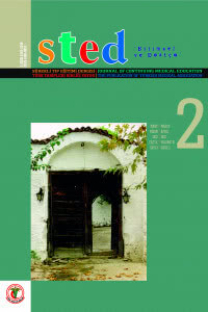Dershaneye giden lise öğrencilerinin dershane sürecinde beslenme tercihleri
Dietary preferences of high school students while attending a private supplementary teaching ınstitution
___
- 1. Çalıştır B, Dereli F, Eksen M, Aktaş S. Muğla Üniversitesi öğrencilerinin beslenme konusunda bilgi düzeylerinin belirlenmesi. Uluslararası İnsan Bilimleri Dergisi 2005; 2 (2):1-8.
- 2. Tanır F, Şaşmaz T, Beyhan Y, Bilici S. Doğankent beldesinde bir tekstil fabrikasında çalışanların beslenme durumu. Mesleki Sağlık ve Güvenlik Dergisi 2001 Temmuz: 22-25.
- 3. Baysal A. Gençliğin beslenme sorunları. Aile ve Toplum Dergisi 1993; 1(3): 45-56.
- 4. Aslan D, Gürtan E, Hacım A, Karaca N, Şenol E, Yıldırım E. Ankarada Eryaman Sağlık Ocağı Bölgesinde bir lisenin ikinci sınıfında okuyan kız öğrencilerin beslenme durumlarının ve bazı antropometrik ölçümlerinin değerlendirmeleri. C. Ü. Tıp Fakültesi Dergisi 2003; 25 (2): 5562.
- 5. Heşeminia T, Çalışkan D, Işık, A. Ankarada yüksek öğretim öğrenci yurtlarında kalan öğrencilerin beslenme sorunları. İbni Sina Tıp Dergisi 2002; 7:155-167.
- 6. Önder FO, Kurdoğlu M, Oğuz G, Özben B, Atilla S, Oral SN. Gülveren Lisesi son sınıf öğrencilerinin bazı beslenme alışkanlıklarının saptanması ve bunun malnütrisyon prevalansı ile olan ilişkisi. Hacettepe Toplum Hekimliği Bülteni 2000; 21(1). http://www.thb.hacettepe.edu.tr/arsiv/2000/ sayi_1/baslik1.pdf Erişim tarihi: 13.11.2012.
- 7.http://megep.meb.gov.tr/mte_program_modul/mo dul_pdf/761CBG054.pdf Erişim tarihi: 13.11.2012.
- 8. Demirezen E, Coşansu G. Adölesan çağı öğrencilerde beslenme alışkanlıklarının değerlendirilmesi. Sürekli Tıp Eğitimi Dergisi 2005; 14(8): 74-79.
- 9. Erkan T. Ergenlerde beslenme. İ.Ü. Cerrahpaşa Tıp Fakültesi Sürekli Tıp Eğitimi Etkinlikleri. Adölesan Sağlığı II Sempozyum Dizisi 2008; 63: 73-77.
- 10. T.C. Sağlık Bakanlığı Temel Sağlık Hizmetleri Genel Müdürlüğü, Hacettepe Üniversitesi Beslenme ve Diyetetik Bölümü. Toplumun beslenmede bilinçlendirilmesi- saha personeli için toplum beslenmesi programı eğitim materyali. Haziran 2002. Erişim tarihi 20 Ocak 2013, http://www.beslenme.gov.tr/content/files /yayinlar/kitaplar/diger_kitaplar/toplumun _beslenmede.pdf
- 11. MEB Örgün Eğitim İstatistikleri. Erişim tarihi 11 Aralık 2012, http://sgb.meb.gov.tr/istatistik/meb_ istatistikleri_orgun_egitim_2011_2012.pdf
- 12. World Health Organisation. Facts on obesity. Erişim tarihi 15 Aralık 2012, http://www.who.int/features/factfiles/ obesity/facts/en/
- 13. Şimşek F, Ulukol B, Berberoğlu M, Başkan SG, Adıyaman P, Öcal G. Ankarada bir ilköğretim okulu ve lisede obezite sıklığı, Ankara Üniversitesi Tıp Fakültesi Mecmuası 2005; 58(4): 163-66.
- 14. Karadamar M. Ergenlerin kilolari ile ilgili algılarının sağlıklı yaşam biçimi davranışları ile ilişkisi. Yüksek lisans tezi 2010. Danışman Yiğit R, Mersin Üniversitesi Sağlık Bilimleri Enstitüsü Hemşirelik Anabilim Dalı.
- 15.Bayrak U. ve ark. Üniversite öğrencilerinin sağlıkla ilgili alışkanlıklar ve kanser konusundaki bilgi ve tutumları. Dokuz Eylül Üniversitesi Tıp Fakültesi Dergisi 2010; 24 (3): 95-104.
- 16) Besler T. Balık tüketimi ve sağlık etkileşimi. Hacettepe Üniversitesi Beslenme ve Diyetetik Bölümü. Erişim tarihi 15 Aralık 2012, http://www.danoneenstitusu.org.tr/ newsfiles/32balikvesagliketkilesimiHTB.pdf,
- 17. Sağlık Bakanlığı Temel Sağlık Hizmetleri Genel Müdürlüğü, Hacettepe Üniversitesi Beslenme ve Diyetetik Bölümü. Türkiyeye özgü beslenme rehberi 2004: 52.
- 18. Yılmaz E, Özkan S. Üniversite öğrencilerinin beslenme alışkanlıklarının incelenmesi. Fırat Sağlık Hizmetleri Dergisi 2007; 2 (6): 87-104.
- 19. Güleç M, Yabancı N, Göçgeldi E, Bakır B. Ankara'da iki kız öğrenci yurdunda kalan öğrencilerin beslenme alışkanlıkları. Gülhane Tıp Dergisi 2008; 50: 102-9.
- ISSN: 1300-0853
- Yayın Aralığı: 6
- Başlangıç: 1992
- Yayıncı: -
Eğitim fakültesi öğrencilerinin hudson & ricketts tutum ölçeğine göre cinsel yönelimlere bakışı
Nurhan Meydan ACIMIŞ, MUSTAFA AGAH TEKİNDAL
Servikal kanserde risk faktörleri, erken tanı yöntemleri, korunma ve hemşirenin rolü
Televizyonun çocukların günlük yaşam etkinlikleri üzerine etkisi
Esma Sülü UĞURLU, F. Nevin ŞİŞMAN, GÜL ERTEM, Nilay ŞEVİK DURMAZ
Sağlıklı okul beslenme programları için adımlar
Suzan GÜNDÜZ, Metin CANBAL, Hatice Mutlu ALBAYRAK
İleri Yaş gebeliklerde biyopsikososyal sorunlar ve yaklaşımlar
BÜŞRA CESUR, ŞÜKRAN ERTEKİN PINAR, ÖZLEM DURAN AKSOY
Halk sağlığı bakış açısıyla halk sağlığı etiği
Dershaneye giden lise öğrencilerinin dershane sürecinde beslenme tercihleri
Mahmut Onur KÜLTÜROĞLU, Dilek MENTEŞOĞLU, Gökçen MEMİŞ, Taha Yusuf KUZAN, Cavit Işık YAVUZ, Songül VAİZOĞLU ACAR
